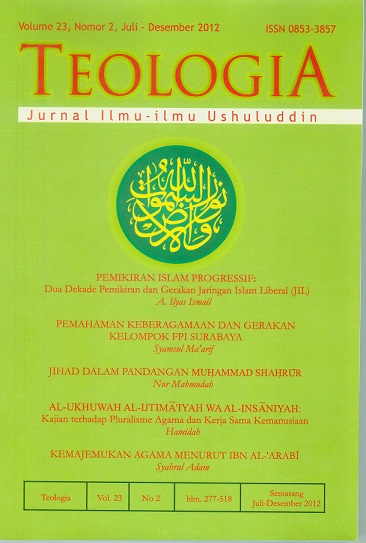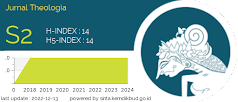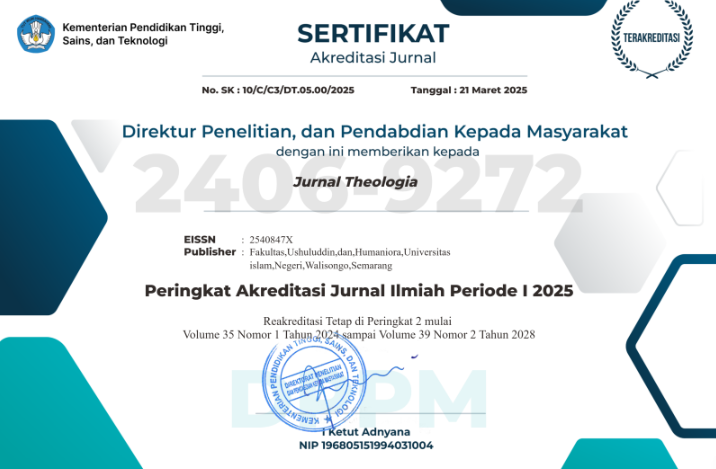KEMAJEMUKAN AGAMA MENURUT IBN AL-‘ARABI
DOI:
https://doi.org/10.21580/teo.2012.23.2.1679Keywords:
wahdat al-wujud, keberagaman agama, tajalli, Ibn al-‘Arabi, Hans KungAbstract
Ibn al-'Arabi> considers that religious pluralism is inevitable necessities. His opinion is actually rooted in his main Sufi he achieved wah}dat al-wuju>d. With such diversity, it is not necessary to the claims of truth (truth claim) on a particular religion. All religions should live together in harmony for the worship of the same God, who is called by different names attributed to differences in the perception of God as well as differences in appearance (tajalli) of God. The understanding of causality religious diversity will make believers can appreciate the existence differences.
Ibn al-‘Arabī menganggap bahwa keberagaman agama merupakan suatu keniscayaan yang tak terelakkan. Pendapatnya tersebut sebenarnya berakar dari konsep utama pemikiran sufistik yang dicapainya yakni wah}dat al-wuju>d. Dengan keragaman tersebut, maka tidak diperlukan adanya klaim-klaim kebenaran (truth claim) pada agama tertentu. Semua agama yang ada harus hidup harmonis sebab sama-sama melakukan penyembahan kepada Tuhan yang sama, yang disebut dengan nama-nama berbeda disebabkan adanya perbedaan persepsi terhadap Tuhan dan juga perbedaan penampakan (tajalli>) Tuhan. Pemahaman terhadap kausalitas keberagaman agama akan membuat penganut agama dapat menghargai perbedaan yang ada.
Downloads
References
Addas, Claude, Quest For The Red Sulphur: The Life of Ibn al-‘Arabī, Cambridge: Golden Palm Series, t.th.
Afifi, A. E., Mystical Philosopy of Muh}yi al-Di>n Ibn al-‘Arabī, Lahore: SH. Muhammad Ashraf, 1964.
Austin, R. W. J., “Ibn ‘Arabī, his Life and Work” Pengantar karya Ibn al-‘Arabī, Sufis of Andalusia: The Ru>h al-Quds and Durrat al-Fa>khirah, terj. R.W.J. Austin, London: George Allen & Unwin Ltd, 1971.
Corbin, Henry, Creative Imagination in The Sufism of Ibn ‘Arabiī terj. Ralph Manheim, Princeton: Princeton University Press, 1969.
Fatta>h}, ‘Abd, al-H{ubb al-Ila>hi fi> Shi‘r Muh}yi al-Di>n bin ‘Arabi>, Kairo: Da>r al-Tsaqa>fah li al-T{aba‘ah wa al-Nashr, 1983.
Glasse, Cyril, “Ibn al-‘Arabī” dalam The Conceise of Encyclopedi of Islam, New York, Philadelphia, London, Mexico City, Sao Paulo, Sydneey: Harper and Raw Publisher, Inc., San Francisco,1989.
Ibn al-‘Arabī, al-Futu>h}a>t al-Makkiyah, diedit oleh Mah}mu>d Mat}raji, Beirut: Dār al-Fikr, 1994.
Ibn al-‘Arabī, Fus}u>s} al-H{ikam, diedit oleh A.E. Afifi, Beirut: Da>r al-Kita>b al-‘Arabi>, 1980.
Ibn al-‘Arabī, Sufis of Andalusia: The Ru>h al-Quds and Durrat al-Fa>khirah, terj. R.W.J. Austin, London: George Allen & Unwin Ltd. 1991.
Kung, Hans, “Sebuah Model Dialog Islam Kristen” dalam Jurnal Pemikiran Islam Paramadina, Volume 1 No. 1 Juli-Desember 1998.
Noer, Kautsar Azhari, “Passing Over: Memperkaya Pengalaman Kegamaan, dalam Komaruddin Hidayat dan Gaus A. F. Passing Over Melintasi Batas-Batas Agama, Jakarta: Gramedia Pustaka Utama, 1998.
Noer, Kautsar Azhari, Ibn al-‘Arabī; Wahdat al-Wujūd dalam Perdebatan, Jakarta: Paramadina, 1996.
Otto, Rudolf, The Idea of the Holy, terj. John W. Harvey dari Dedicated to Theodor Von Haring, New York: Oxford University Press, 1958.
Qa>sim, Mah}mu>d, Muh}yi al-Di>n bin ‘Arabi> wa Leibniz, Kairo: Maktabah al-Qa>hirah al-H{adi>tsah, 1972.
Rabbani, Cap. Wahid Bakhsh, Islamic Sufism, Kuala Lumpur: As. Noordeen, 1990.
Shah, Idries, The Way of Sufi, England: Peguin Book Ltd., 1968.
Smith, Margaret, Readings from The Mystiics of Islam, Wesport: Pir Publication, 1994.





















